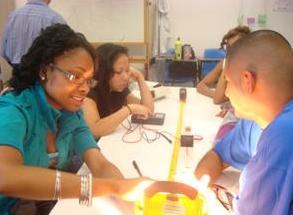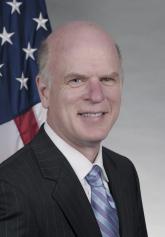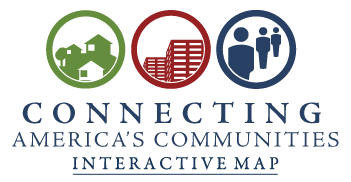Blog
Broadband Opportunities Reach Philadelphia
Freedom Rings Partnership Helps to Close Digital Divide
Guest post by Arun Prabhakaran and Mary-Anne Smith Harris of the Urban Affairs Coalition
The Freedom Rings Partnership officially kicked off on January 17th, by sponsoring the signature project of the Greater Philadelphia Martin Luther King Day of Service – volunteers refurbished used computers to be distributed to the community, assembled digital literacy kits, and participated in a high-tech scavenger hunt called “Race to Connect.” Tom Power, NTIA Chief of Staff, joined Sharmain Matlock-Turner, President and CEO of the Urban Affairs Coalition (UAC); John Fry, President of Drexel University; and Philadelphia Mayor Michael Nutter for this exciting event hosted at Girard College.
The Freedom Rings Partnership, led by UAC and the City of Philadelphia, with Drexel University as a major partner, is made up of grassroots organizations, government, and universities that are working to bring Internet access, jobs-training, and technology to Philadelphia residents in low-income communities. This initiative is a synergy between two BTOP Round 2 grants: UAC’s $11.8 million Sustainable Broadband Adoption project and the City of Philadelphia’s $6.4 million Public Computer Center project. Together, these two initiatives are known as the Freedom Rings Partnership, bringing over $25 million in federal and matching dollars to bridge the digital divide in Philadelphia.

NTIA Chief of Staff Tom Power refurbishes a computer for the Freedom Rings project with the help of Philadelphia youths
Report from the Field: Advancing Public Safety Broadband Communications
700-MHz Demonstration Stakeholder Meeting in Boulder
Earlier this month, representatives from each of the seven BTOP 700 MHz wireless broadband public safety projects spent time at the Department of Commerce Research Labs in Boulder learning about the most recent developments in LTE wireless broadband technology.
Approximately 300 stakeholders, who were interested in the new wireless broadband technology and how this commercial technology could be adapted by public safety using the 700 MHz broadband spectrum, attended the meeting. Attendees included representatives from state, local, and federal government agencies, equipment manufacturers, cellular service providers, and other stakeholder associations. It was one of the largest events ever held at the Boulder campus and included opening remarks by Department of Homeland Security Assistant Secretary Greg Schaffer and NTIA Deputy Administrator Anna Gomez.
This event was sponsored by the Public Safety Communications Research (PSCR) program, a government-sponsored program that performs research to advance public safety communications interoperability. PSCR is a joint effort between the National Institute of Standards and Technology’s Office of Law Enforcement Standards and NTIA’s Institute for Telecommunication Sciences. The PSCR program is building a 700-MHz Public Safety Broadband Demonstration Network to provide manufacturers and first responders a location for early deployment of their public safety systems in a multi-vendor, neutral, host environment.
Tracking BTOP Project Progress
This week, NTIA posted the most recent quarterly reports of BTOP recipients. It’s terrific to see these projects really begin to take off – from public computer centers opening, to infrastructure project groundbreakings, to sustainable broadband adoption training beginning – the benefits are becoming more and more visible.
For example, South Dakota Network’s $21 million infrastructure project began construction at several sites already, and construction is being accelerated into 2011. Also, the North Florida Broadband Authority’s $30 million infrastructure project has taken off in the last quarter: despite initial delays, its technical work over the last few months has resulted in the project exceeding the reliability and capacity hoped for in its application – at lower cost to boot.
Michigan State University’s Round 1 Public Computer Center project is rolling into the home stretch – it is running ahead of schedule and will essentially be complete by the end of this month. The computer centers upgraded so far are showing higher usership than anticipated, which validates the University’s Round 2 award to extend the Round 1 project significantly.
And One Community’s $19 million multi-state Sustainable Broadband Adoption project is also gaining momentum – project administrators and supervisors have been hired, training curriculum was developed, outreach to 130,000 people was conducted, and digital literacy training began for 1,100 people.
BTOP: A Look back, a Look Ahead
As we approach the end of the year, it is a fitting time to reflect on what we’ve accomplished with BTOP and the work that lies ahead. Today we’re issuing a report that provides an overview of BTOP grants, highlighting illustrative projects in each category – infrastructure, public computer centers, and sustainable broadband adoption initiatives – and discussing the benefits to various stakeholder groups, including schools, small businesses, people with disabilities, the unemployed, and seniors, to name a few.
Though we are proud of what we have achieved – quickly building a solid grant program from the ground up, performing thorough due diligence on an avalanche of applications, and awarding grants to more than 230 strong proposals – the projects we awarded are a testament to the hard work and ingenuity of grantees, many of whom worked with partners throughout their communities to create innovative solutions to their local broadband needs.
But now is when the rubber hits the road. As the report makes clear (and to continue the metaphor), a lot is riding on these investments – not simply improved broadband access and adoption but also greater economic opportunities and advancements in education, health care, and public safety. We are pleased that BTOP projects are making good progress; we’ve seen groundbreakings for infrastructure projects, new and upgraded public computer centers serving the public, and training programs underway. There is much more to be done, however. NTIA is now focused squarely on strong oversight and providing the necessary technical assistance to grantees. Given all that’s at stake, we are determined to see that these projects are completed on time, within budget, and deliver the promised benefits to the communities they serve.
Exploring the Digital Divide
NTIA and the Department of Commerce's Economics and Statistics Administration (ESA) recently released a report that analyzes broadband Internet adoption and use across the United States. “Exploring the Digital Nation,” the new study, finds that although socio-economic factors like income and education are strongly associated with broadband Internet use, they are not the sole determinants of adoption. Even after accounting for socio-economic factors, significant gaps in broadband adoption persist along racial, ethnic, and geographic lines. For example, White households had higher broadband adoption rates than African American and Hispanic households, and urban residents were more likely than their rural counterparts to adopt broadband Internet, even after adjusting for socio-economic factors.
Americans who did not use the Internet at all – whether inside or outside the home – most commonly cited lack of interest or need as the primary reason. In contrast, those who lacked the Internet at home but who did use it elsewhere most commonly cited affordability as the reason they were not subscribers, as did those who only had dial-up Internet access at home.
The report’s findings are based on data collected through a survey of approximately 54,000 households and 129,000 citizens – the largest survey of its kind. Commissioned by NTIA and conducted by the U.S. Census Bureau, the survey provides compelling information on the state of broadband Internet use across America, including an unprecedented level of examination of Internet adoption by persons with disabilities.
In addition, the report makes a pioneering use of regression analysis, adjusting the findings for socio-economic factors in order to achieve a greater understanding of the digital divide.
Report from the Field: Digital Summer Jobs for Chicago Youth
Guest post by Matthew Guilford of the City of Chicago
The SmartChicago Sustainable Broadband Adoption project is developing innovative approaches to drive broadband adoption in Chicago. The project is funded by BTOP, managed by Local Initiatives Support Corporation/Chicago, and is a part of Chicago Mayor Richard M. Daley’s Digital Excellence Initiative.
A major component of this sustainable broadband adoption project is to engage youth, not only as the next generation of broadband subscribers, but also as drivers of broadband adoption for their families. The Digital Youth Summer Jobs (DYSJ), a program made possible by the SmartChicago project, is providing technology-oriented employment and training to 120 underserved youth as well as outreach activities to 120 parents or caregivers.
DYSJ is already having an impact on Chicago’s future innovators. This summer, 60 youth from the Smart Communities program were placed in technology-oriented jobs at over 30 work sites. I connected with Raven, a rising high school senior who worked this summer at Columbia College in Chicago, to understand how the DYSJ program has impacted her engagement with technology and her career goals.

Digital Youth Summer Jobs student participants learning about technology and digital media during their summer internship at Columbia College in Chicago.
Broadband Stimulus Update from the Assistant Secretary
Now that all the broadband stimulus grants have been awarded I’d like to spend a few moments discussing what we’ve accomplished and what lies ahead. In less than 20 months, NTIA built a multi-billion dollar grant program from the ground up. This is the largest grant program that NTIA has ever managed and is one of the largest ever managed at the Department of Commerce. We had to hire staff, build the information systems, develop the rules, perform due diligence on the proposals, and award over $4 billion in grants, all before this past September 30. At every step of the way, we solved the challenges that arose, we answered the skeptics who said we would never get the money out, and ended up with what I think is a very solid set of sustainable projects that will not only expand broadband access and adoption but will also lead to economic growth and job creation. These projects will also continue to pay dividends far into the future in the form of improved education and health care, heightened innovation, and long-term local, national, and global economic growth.
Let me summarize our portfolio of projects. We funded four types of projects: infrastructure, public computer centers, sustainable broadband adoption projects, and state broadband data and development initiatives. These projects reach every state and territory and will:
- Fund the construction or upgrade of approximately 120,000 miles of broadband networks.
- Provide broadband access to approximately 24,000 community anchor institutions, including schools, libraries, government offices, health care facilities, and public safety entities. Of these, approximately:
- 3,000 are healthcare entities, including hospitals, clinics, and physicians’ offices
- 5,000 are public safety entities, such as first responders, fire, police, and EMS
- 7,000 are K-12 schools
- 600 are community colleges
- 2,000 are libraries
Celebrating Collaboration in the Great Lakes State
Guest post by Greg Monroe, Grants, Development and Communications Specialist, Merit Network
Recently, Merit Network had the pleasure of welcoming state and federal officials to our headquarters. They joined us to celebrate the culmination of multiple BTOP awards that together will deliver the transformative power of broadband to communities throughout Michigan. The excitement we shared with the many stakeholders who participated in our grant announcement event in August is as strong today as it was when we first learned of our award. During the event, I could not help but think how incredibly gratifying it is to know that all the hard work put into the planning and application will soon become a reality.
For over 40 years, our organization has worked together with others to achieve the most for our members. It is this same spirit of collaboration that underscored the vision and efforts of so many that were the focus of Merit’s broadband grant announcement and this project going forward.
Our project, REACH-3MC will create over 2,000 miles of fiber-optic infrastructure that will serve all sectors of society. This will be accomplished through a unique public-private partnership that engages Merit, a non-profit, and eight commercial providers who will own strands of fiber over various segments of the network.
BTOP’s Reach to Community Colleges
By Laura Breedon, BTOP Program Director for Public Computing and Broadband Adoption
Last week, Dr. Jill Biden hosted the first ever White House Summit on Community Colleges, at which President Obama spoke.
The summit brought together community colleges, businesses, philanthropic organizations, federal and state policy leaders, and faculty and students to discuss how community colleges can help meet the job training and education needs of the American workforce.
Here at NTIA we are well aware of the critical role these anchor institutions play in their communities, and investing in broadband technologies for these institutions is a top priority. In fact, BTOP projects plan to directly connect approximately 600 community colleges across the country to broadband. These are among the 24,000 community anchor institutions that will be connected via BTOP projects.
The projects will provide high-speed connections that will enable students and faculty to use remote data sets, simulations, and other tools to learn and practice new skills as well as to collaborate with other classrooms in real-time. They will also improve education by bringing distance learning to schools in remote areas, enabling students to conduct online research, and helping teachers and parents to communicate with one another.
BTOP projects will also support public computer centers; jobs skills, computer, and workforce development training; and digital literacy initiatives on community college campuses throughout the United States. Some examples:
Connecting with BroadbandMatch
Earlier this year, at the start of Round Two, BTOP partnered with USDA’s Broadband Initiatives Program, to launch BroadbandMatch, an online tool that allowed potential broadband grant applicants to find partners for their projects, helping them to combine expertise and create stronger proposals. Conceived as part of the Obama Administration’s Open Government Initiative, the tool enabled applicants and would-be partners to see not only which small and minority-owned companies might supply goods or services for their projects, but also which nonprofit organizations, educational institutions and state and municipal governments were taking the initiative to improve broadband access and digital literacy.

Now, In response to positive feedback, and to promote continued broadband deployment and adoption, BroadbandMatch is here to stay. NTIA is re-launching the tool as an ongoing resource for communities pursuing broadband projects and programs. This tool can help BTOP grantees identify prospective vendors as they implement their projects, and it can aid businesses, non-profits, and state and local governments find potential partners to collaborate on broadband initiatives.
Though the grant application window was only open a few short weeks, over 1400 organizations established profiles on the BroadbandMatch site. This included hundreds of community anchor institutions like libraries and community colleges, hundreds more Internet service providers, dozens of small and minority-owned for-profit businesses, over a hundred states or municipalities, as well as various technology vendors, public safety institutions, venture capital firms and tribal entities.













